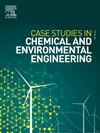评估发动机性能和排放使用汽油,乙醇和燃料油的混合物
Q1 Environmental Science
Case Studies in Chemical and Environmental Engineering
Pub Date : 2024-12-13
DOI:10.1016/j.cscee.2024.101065
引用次数: 0
摘要
本研究调查了在不同发动机转速(1000-3000 rpm)和油门位置(10 - 40%)下,汽油、乙醇和杂醇油混合物对发动机性能和排放的影响。混合燃料降低了3.5 - 7.1%的制动功率,增加了6.1% - 16.8%的乙醇和4.6 - 15.9%的燃油消耗。两种混合物的制动热效率也有所下降。然而,排放显著改善,NOx(乙醇)和13.8%(燃油)分别减少了17.3%和13.8%,CO减少了13.1%和9.1%,HC减少了8.8%和6.16%。结果突出了性能和排放效益之间的权衡。本文章由计算机程序翻译,如有差异,请以英文原文为准。
Evaluation of engine performance and emissions using blends of gasoline, ethanol, and fusel oil
This study investigates the impact of gasoline, ethanol, and fusel oil blends on engine performance and emissions under varying engine speeds (1000–3000 rpm) and throttle positions (10–40 %). The blends reduced brake power by 3.5–7.1 % and increased Brake-Specific Fuel Consumption by 6.1–16.8 % for ethanol and 4.6–15.9 % for fusel oil. Brake thermal efficiency also declined for both blends. However, emissions improved significantly, with NOx reductions of 17.3 % (ethanol) and 13.8 % (fusel oil), CO reductions of 13.1 % and 9.1 %, and HC reductions of 8.8 % and 6.16 %, respectively. The results highlight trade-offs between performance and emission benefits.
求助全文
通过发布文献求助,成功后即可免费获取论文全文。
去求助
来源期刊

Case Studies in Chemical and Environmental Engineering
Engineering-Engineering (miscellaneous)
CiteScore
9.20
自引率
0.00%
发文量
103
审稿时长
40 days
 求助内容:
求助内容: 应助结果提醒方式:
应助结果提醒方式:


